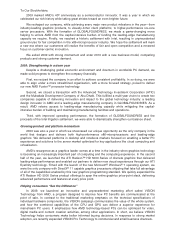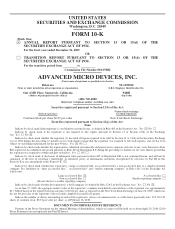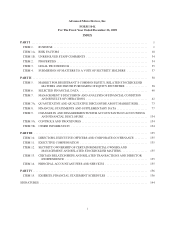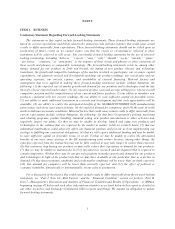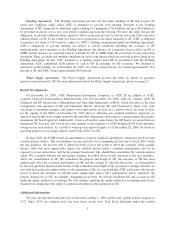AMD 2009 Annual Report Download - page 13
Download and view the complete annual report
Please find page 13 of the 2009 AMD annual report below. You can navigate through the pages in the report by either clicking on the pages listed below, or by using the keyword search tool below to find specific information within the annual report.Developments in circuit design and manufacturing process technologies have resulted in significant
advances in microprocessor performance. Currently, microprocessors are designed to process 32-bits or 64-bits
of information at one time. The bit rating of a microprocessor generally denotes the largest size of numerical data
that a microprocessor can handle. Microprocessors with 64-bit processing capabilities enable systems to have
greater performance by allowing software applications and operating systems to access more memory.
Moreover, as businesses and consumers require greater performance from their computer systems due to the
exponential growth of digital data and increasingly sophisticated software applications, semiconductor companies
are designing and developing multi-core microprocessors, where multiple processor cores are placed on a single die
or in a single processor. Multi-core microprocessors offer enhanced overall system performance and efficiency
because computing tasks can be spread across two or more processing cores each of which can execute a task at full
speed. Moreover, multiple processor cores packaged together can increase performance of a computer system
without greatly increasing the total amount of power consumed and the total amount of heat emitted. This type of
“symmetrical multiprocessing” is effective in both multi-tasking environments where multiple cores can enable
operating systems to prioritize and manage tasks from multiple software applications simultaneously and also for
“multi-threaded” software applications where multiple cores can process different parts of the software program, or
“threads,” simultaneously thereby enhancing performance of the application. Businesses and consumers also require
computer systems with improved power management technology, which allows them to reduce the power
consumption of their computer systems thereby reducing the total cost of ownership.
While general purpose computer architectures based on the x86 architecture are sufficient for a large portion
of customers, for selected applications, an architecture that enables the ideal resource to be used for a given
workload can provide a substantial improvement in user experience, performance and energy efficiency. In this
environment, we believe our vision of “heterogeneous computing” and an accelerated computing architecture can
benefit customers. Heterogeneous computing refers to computer systems that rely on multiple computational
units such as the CPU and the GPU. An accelerated computing architecture enables “offloading” of selected
tasks, thereby optimizing the use of a CPU or GPU, depending on the application or workload. For example,
serial workloads are better suited for CPUs while highly parallel tasks may be better performed by a GPU. Our
vision for an accelerated computing architecture is that the CPU and GPU components are combined onto a
single piece of silicon, which we refer to as an AMD Fusion Accelerated Processing Unit (or APU). We believe
that high performance computing workloads, workloads that are visual in nature and even traditional applications
such as photo and video editing or other multi-media applications stand to benefit from our accelerated
computing architecture and heterogeneous computing approach.
Microprocessor Products
We currently offer microprocessor products for servers, workstations, notebooks and desktop PCs. We base
our microprocessors and chipsets on the x86 instruction set architecture and AMD’s Direct Connect Architecture,
which connects an on-chip memory controller and input/output, or I/O, channels directly to one or more
microprocessor cores. We typically integrate two or more processor cores onto a single die, and each core has its
own dedicated cache, which is memory that is located on the semiconductor die, permitting quicker access to
frequently used data and instructions. Some of our microprocessors have additional levels of cache such as L2, or
second level cache, and L3, or third level cache, to enable faster data access and higher performance.
Our processors and chipsets support multiple generations of HyperTransport™ technology, which is a high-
bandwidth communications interface that enables higher levels of multi-processor performance and scalability
over traditional front side bus-based microprocessor technology. Energy efficiency and power consumption
continue to be key design principles for our products. We focus on continually improving power management
technology, or “performance-per-watt.” To that end, we offer processors and chipsets with features that are
designed to reduce system level energy consumption, with multiple levels of lower clock speed and voltage states
that can significantly reduce processor power consumption during idle times. We design our microprocessors to
be compatible with operating system software such as the Microsoft®Windows®family of operating systems,
Linux®, NetWare®, Solaris and UNIX.
5


